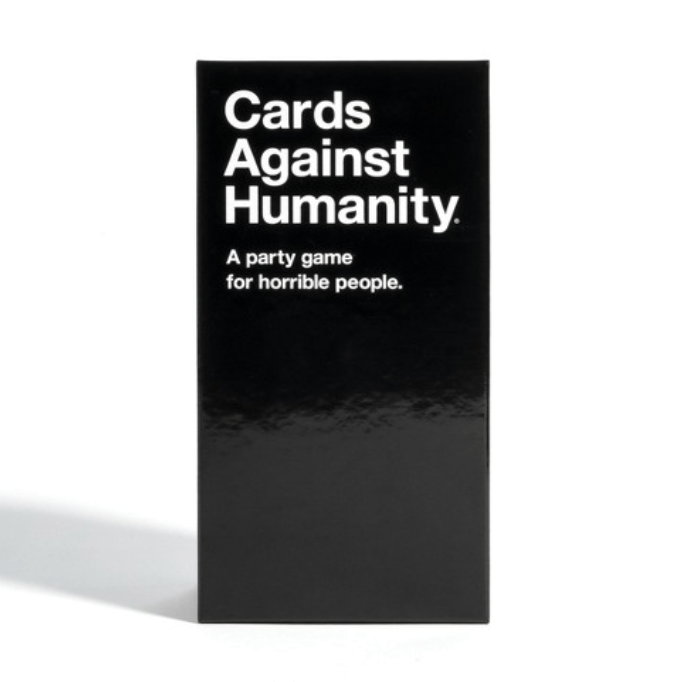Cards Against Humanity (CAH) is a social judging game designed by eight Highland Park High School alumni and published by Cards Against Humanity LLC. It was released in 2011 and is now known for risque and politically incorrect humor. The target audience is ages 17+ and the game supports 3 to 20 players. It is a fill in the blank style card game in which a judge picks the best card to win each round.
In each round of CAH, the judge picks the winning card, and the player who played that card becomes the next judge (though some players use a variation in which the judge rotates). CAH successfully prioritizes fun, humor, and creativity by building flexibility into the judging procedures and the rules. I argue that by switching the judge and leaving judging criteria subjective, CAH facilitates fellowship and discovery as its main aesthetics, deprioritizing the competition aesthetic that is prominent in many card games.
First, there is a dynamic in which players who can best predict the judge’s sense of humor are rewarded. This dynamic arises as a result of the game’s formal elements: the objective is to outwit other players by using the right card at the right time (dependent on the prompt and judge) and the procedures make the judge switch between players. These formal elements affect player strategy. For instance, one of the players reported “I’m saving this card for when Paige is the judge” because they knew that I would find the card funny. Notably, this is different from Apples to Apples, a similar game to CAH; the objective is less about outwitting through understanding other players and more about objectively matching nouns to adjectives.
This dynamic extends the Magic Circle beyond the game, as knowing what makes other players laugh is important. During our game, close friends often repeatedly chose each other’s cards. For instance, my friend and I picked each other’s cards to win five times in a row (because we have similar senses of humor) despite the submissions being anonymous. However, this dynamic does not require previously knowing the other players; judging styles usually become clear after a few rounds. Later in the game, another player and I picked each other’s cards to win many times in a row. By this point in the game, we had learned each other’s sense of humor and felt closer because of it. These feelings support the obvious yet important argument that fellowship is a strong aesthetic in CAH.
CAH does not provide specific procedures for judges when picking a winning card. This mechanic gives rise to a dynamic in which judging criteria is extremely subjective and often changes. For instance, sometimes the “best” card wins while sometimes the most “fitting” card wins. Therefore, sometimes cards that have the most ridiculous or funny contents win(the examples I could give are probably not appropriate for this blog post) while other times cards that best match the prompt win. Moreover, some judges prioritize group reactions, meaning in some of our rounds, there was a clear winner because all of us could not stop laughing at one pairing. In addition to fellowship, the variable judging criteria dynamic facilitates discovery as a main aesthetic for the game, as players are encouraged to come up with witty and novel responses.
Discovery as an aesthetic is also supported by the fact that players continue to play CAH with the same sets of cards because there are always new prompt/card pairings. This aesthetic is obviously supported by a player’s main resource: the cards themselves. CAH cards are variable and outrageous, and the game designers create a procedure in which players always have ten cards to choose from. This successfully allows the players freedom to pick a card without overwhelming them with choices, leading to stress-free yet constrained discovery and creativity.
Finally, CAH is not designed to create competition as a main aesthetic, despite the fact that it is a card game with a winner each round. The resources are funny and entertaining, and the rules and procedures do not define a clear way to crown a winner. When we played, we counted up the prompt cards at the end to decide who won, but no one seemed to care very much about how they did.
To conclude, CAH’s notable formal elements are its unique cards as inventory, vague rules for winning, rotating judging procedures, and extensive Magic Circle. These elements create several dynamics including players learning one another’s styles of humor, judges using varying criteria to select a winner, players’ ambivalence towards winning, and players’ willingness to play the game again with the same deck of cards. Fellowship and discovery are the main aesthetics experienced in the game, while competition fades to the background.




